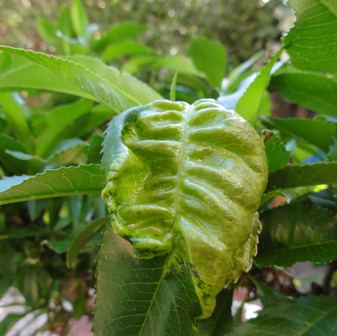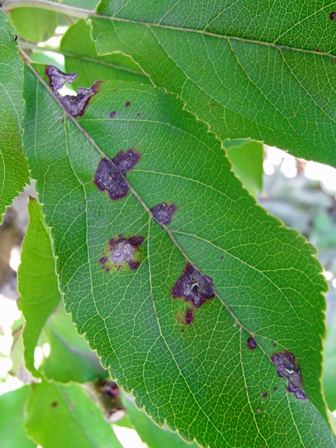Although it may look like there is not much happening with your fruit trees over winter, the microscopic world of fungi is making plans, strategically laying in wait in the cracks and crevices of your trees until the weather warms up. The most prevalent fungus is Peach Leaf Curl, causing the disfigurement of leaves, and sometimes the fruit, on your peach, nectarine, apricots and even almonds. However there are many other fungal problems that may occur and winter spraying is a good way to help reduce the incidence of fungal problems.

Other fungal diseases that may be dormant on stone fruit include Shot Hole, Freckle Spot, Rust and Powdery Mildew.
There are several things you can do to minimise the spread of Peach Leaf Curl and other fungal diseases in the garden.
Practise good garden hygiene. Pick up fallen leaves from the ground and avoid putting them in your compost. Remove damaged or rotten fruit and keep the tree pruned to an open vase shape to increase air circulation.
Plant your tree into well prepared soil in the right position with plenty of sun and good air circulation. Keep up a regular fertilising and watering schedule.
Spray your trees during winter with a low impact fungicide. ‘Winter-washing’ helps to kill off any spores and can greatly reduce the incidence of Peach Leaf Curl and other fungal problems.
Winter Washing
The best spray to use is either copper oxychloride or lime sulphur sprayed in alternate years. The first spray should be in late autumn at leaf fall just before the tree enters its dormancy. Spray again at bud swell or bud burst in late winter or early spring. Once the leaves have opened out it is too late to spray for Peach Leaf Curl and many other fungal diseases. Safe and effective spraying can only be done at the end of the following summer.
When spraying fruit trees, be aware of the potential impact that ‘spray drift’ may have on surrounding vegetation, soil micro-organisms, pets and humans. Spraying is usually done to the point of ‘run-off’, where the spray liquid has completely covered the tree surface and runs off on to the ground. It may be prudent to lay spray sheets down so non-targeted areas are being protected.
Only make up enough spray for the job at hand to avoid the problem of having to dispose of excessive amounts of unused spray.
Spraying may not be 100% effective so be vigilant over summer and remove any leaves showing signs of fungal disease as soon as they appear.
Related Articles:
Garden Journaling – Slow down to tune in.
As we move through the year and our gardens evolve, there's something magical about documenting the journey. Garden journaling is an art that enables…
The Importance of building soil health for a biodeverse, productive garden
Creating a thriving garden that not only sustains itself but also contributes to the broader ecosystem requires more than just sunlight and water.…




